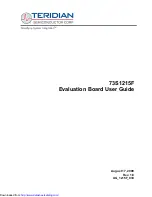
UG_1215F_039
73S1215F Evaluation Board User Guide
Rev. 1.8
9
2.2 Loading User Code into the Evaluation Board
Hardware Interface for Programming
The signals listed in
are necessary for communication between the TFP2 or ICE and the
73S1215F.
Table 1: Flash Programming Interface Signals
Signal
Direction
Function
E_TCLK
Output from 73S1215F
Data clock
E_RXTX
Bi-directional
Data input/output
E_RST
1
Bi-directional
Flash Downloader Reset (active low)
1
The E_RST signal should only be driven by the TFP2 when enabling these
interface signals. The TFP2 must release E_RST at all other times.
, along with 3.3 V and GND, are available on the emulator header J11. Production
modules may be equipped with much simpler programming connectors, e.g. a 5x1 header.
Programming of the flash memory requires either the Signum Systems ADM51 in-circuit emulator or the
TSC Flash Programmer Model TFP2 provided by Teridian.
Loading Code with the In-Circuit Emulator
If firmware exists in the 73S1215F flash memory, the memory must be erased before loading a new file
into memory. In order to erase the flash memory, the RESET button in the emulator software must be
clicked followed by the ERASE button (see
Once the flash memory is erased, a new file can be loaded using the Load command in the File menu.
The dialog box shown in
makes it possible to select the file to be loaded by clicking the Browse
button. Once the file is selected, pressing the OK button loads the file into the flash memory of the IC.
At this point, the emulator probe (cable) can be removed. Once the 73S1215F device is reset using the
reset button on the evaluation board, the new code starts executing.
Loading Code with the TSC Flash Programmer Model TFP2
Follow the instructions given in the TSC Flash Programmer Model TFP2 User’s Manual.
http://www.datasheetcatalog.com/
























